
Pterodactylus is a genus of extinct pterosaurs. It is thought to contain only a single species, Pterodactylus antiquus, which was the first pterosaur to be named and identified as a flying reptile and one of the first prehistoric reptiles to ever be discovered.

Quetzalcoatlus is a genus of azhdarchid pterosaur that lived during the Maastrichtian age of the Late Cretaceous in North America. The type specimen, recovered in 1971 from the Javelina Formation of Texas, United States, consists of several wing fragments and was described as Quetzalcoatlus northropi in 1975 by Douglas Lawson. The first part of the name refers to the Aztec serpent god of the sky, Quetzalcōātl, while the second part honors Jack Northrop, designer of a tailless fixed-wing aircraft. The remains of a second species were found between 1972 and 1974, also by Lawson, around 40 km (25 mi) from the Q. northropi locality. In 2021, these remains were assigned the name Quetzalcoatlus lawsoni by Brian Andres and (posthumously) Wann Langston Jr, as part of a monograph on the genus.

Rhamphorhynchus is a genus of long-tailed pterosaurs in the Jurassic period. Less specialized than contemporary, short-tailed pterodactyloid pterosaurs such as Pterodactylus, it had a long tail, stiffened with ligaments, which ended in a characteristic soft-tissue tail vane. The mouth of Rhamphorhynchus housed needle-like teeth, which were angled forward, with a curved, sharp, beak-like tip lacking teeth, indicating a diet mainly of fish; indeed, fish and cephalopod remains are frequently found in Rhamphorhynchus abdominal contents, as well as in their coprolites.

Scaphognathus was a pterosaur that lived around Germany during the Late Jurassic. It had a wingspan of 0.9 m (3 ft).

Anurognathus is an extinct genus of small pterosaur from the Late Jurassic Altmühltal Formation of Germany. Anurognathus was first named and described by Ludwig Döderlein in 1923. The type species is Anurognathus ammoni. The specific name ammoni honours the Bavarian geologist Ludwig von Ammon, from whose collection Döderlein had acquired the fossil in 1922.
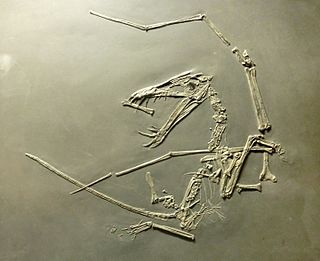
Dorygnathus was a genus of rhamphorhynchid pterosaur that lived in Europe during the Early Jurassic period, when shallow seas flooded much of the continent. It had a short wingspan around 1.5 meters, and a relatively small triangular sternum, which is where its flight muscles attached. Its skull was long and its eye sockets were the largest opening therein. Large curved fangs that "intermeshed" when the jaws closed featured prominently at the front of the snout while smaller, straighter teeth lined the back.
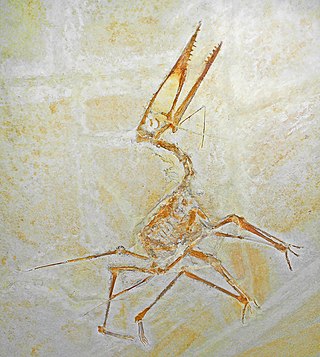
Germanodactylus is a genus of germanodactylid pterodactyloid pterosaur from Upper Jurassic-age rocks of Germany, including the Solnhofen Limestone. Its specimens were long thought to pertain to Pterodactylus. The head crest of Germanodactylus is a distinctive feature.

Campylognathoides is an extinct genus of pterosaur discovered in the Württemberg Lias deposits of Germany; this first specimen however, consisted only of wing fragments. Further better preserved specimens were found in the Holzmaden shale; based on these specimens, Felix Plieninger erected a new genus.

Cycnorhamphus is a genus of gallodactylid ctenochasmatoid pterosaur from the Late Jurassic period of France and Germany, about 152 million years ago. It is synonymous with the genus Gallodactylus.
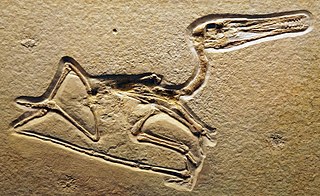
Diopecephalus is a genus of pterodactyloid pterosaur from the Lower Tithonian of the Lithographic Limestone, Bavaria, Germany. The type and only species is D. kochi, although the name has been applied to Pterodactylus longicollum, with longicollum erroneously listed as the type species.

Altmuehlopterus is a genus of pterosaur belonging to the Pterodactyloidea. It lived in the Late Jurassic of what is now Germany. It was formerly known as "Daitingopterus", a nomen nudum, informally coined in 2004.
Paleontology or palaeontology is the study of prehistoric life forms on Earth through the examination of plant and animal fossils. This includes the study of body fossils, tracks (ichnites), burrows, cast-off parts, fossilised feces (coprolites), palynomorphs and chemical residues. Because humans have encountered fossils for millennia, paleontology has a long history both before and after becoming formalized as a science. This article records significant discoveries and events related to paleontology that occurred or were published in the year 1856.
Paleontology or palaeontology is the study of prehistoric life forms on Earth through the examination of plant and animal fossils. This includes the study of body fossils, tracks (ichnites), burrows, cast-off parts, fossilised feces (coprolites), palynomorphs and chemical residues. Because humans have encountered fossils for millennia, paleontology has a long history both before and after becoming formalized as a science. This article records significant discoveries and events related to paleontology that occurred or were published in the year 1831.
Paleontology or palaeontology is the study of prehistoric life forms on Earth through the examination of plant and animal fossils. This includes the study of body fossils, tracks (ichnites), burrows, cast-off parts, fossilised feces (coprolites), palynomorphs and chemical residues. Because humans have encountered fossils for millennia, paleontology has a long history both before and after becoming formalized as a science. This article records significant discoveries and events related to paleontology that occurred or were published in the year 1812.
Paleontology or palaeontology is the study of prehistoric life forms on Earth through the examination of plant and animal fossils. This includes the study of body fossils, tracks (ichnites), burrows, cast-off parts, fossilised feces (coprolites), palynomorphs and chemical residues. Because humans have encountered fossils for millennia, paleontology has a long history both before and after becoming formalized as a science. This article records significant discoveries and events related to paleontology that occurred or were published in the year 1843.
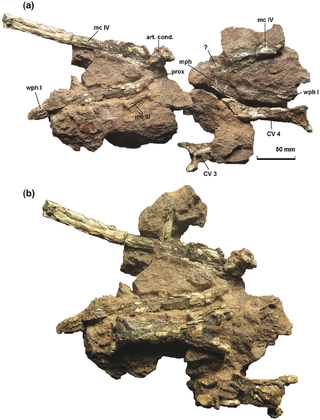
Eurazhdarcho is a genus of azhdarchid pterosaur that lived during the Maastrichtian age of the Late Cretaceous period in what is now Romania, about 69 million years ago. Starting in 2009, pterosaur fossil remains were unearthed in a layer of the Sebeș Formation in Lancrăm, southwestern Transylvania by paleontologist Mátyás Vremir. In 2013, he, along with paleontologists Alexander Kellner, Darren Naish, and Gareth Dyke would name the new genus and type species Eurazhdarcho langendorfensis. Its generic name is a combination of Europe and the genus Azhdarcho, while its specific name is in reference to its origin from Langendorf. The holotype specimen of Eurazhdarcho consists of a partial skeleton that includes cervical (neck) vertebrae, metacarpal, and phalanx fragments. The related and much larger azhdarchid Hatzegopteryx has also been found in the same location, indicating a possibility that Eurazhdarcho may have a juvenile of this pterosaur. However, the describers deemed this unlikely as its fossils seem to represent an adult specimen.

Aerodactylus is a pterosaur genus containing a single species, Aerodactylus scolopaciceps, previously regarded as a species of Pterodactylus.

This timeline of pterosaur research is a chronologically ordered list of important fossil discoveries, controversies of interpretation, and taxonomic revisions of pterosaurs, the famed flying reptiles of the Mesozoic era. Although pterosaurs went extinct millions of years before humans evolved, humans have coexisted with pterosaur fossils for millennia. Before the development of paleontology as a formal science, these remains would have been interpreted through a mythological lens. Myths about thunderbirds told by the Native Americans of the modern Western United States may have been influenced by observations of Pteranodon fossils. These thunderbirds were said to have warred with water monsters, which agrees well with the co-occurrence of Pteranodon and the ancient marine reptiles of the seaway over which it flew.
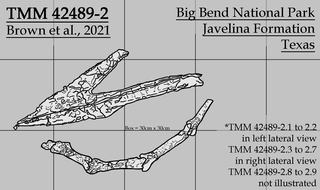
Wellnhopterus is a genus of azhdarchid pterosaur that lived during the Maastrichtian age of the Late Cretaceous period in what us now Texas, United States. Its fossil remains were discovered in the Javelina Formation at Big Bend National Park, located in Brewster County, Texas. The fossils consist of a set of upper and lower jaws, several cervical (neck) vertebrae, and a fragmentary long bone. Originally referred to an indeterminate species of Quetzalcoatlus, these remains would receive various interpretations ranging from a tapejarid to an azhdarchid identity. It was not until December 2021 that they were given a new genus and type species, Wellnhopterus brevirostris, named and described by paleontologists Brian Andres and, posthumously, Wann Langston Jr.. Its generic name means "Wellnhofer's wing", named in honor of paleontologist Peter Wellnhofer, while its specific name means "short-beaked", attributing to the blunt structure of its jaws.
Paleontology or palaeontology is the study of prehistoric life forms on Earth through the examination of plant and animal fossils. This includes the study of body fossils, tracks (ichnites), burrows, cast-off parts, fossilised feces (coprolites), palynomorphs and chemical residues. Because humans have encountered fossils for millennia, paleontology has a long history both before and after becoming formalized as a science. This article records significant discoveries and events related to paleontology that occurred or were published in the year 1810.















